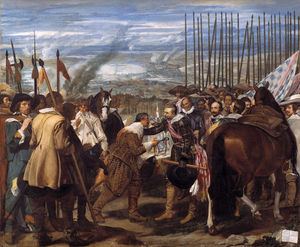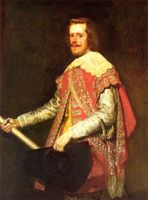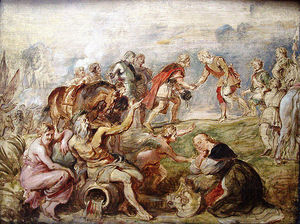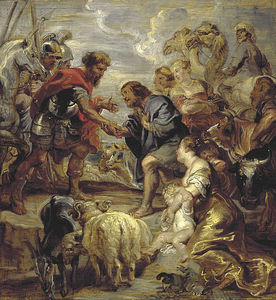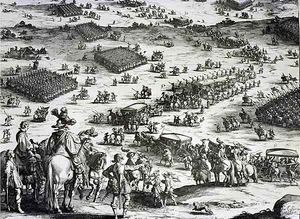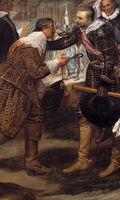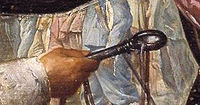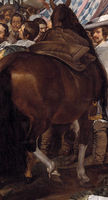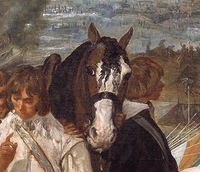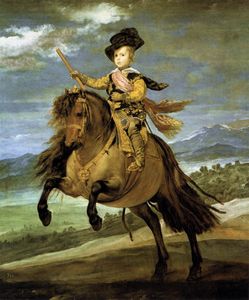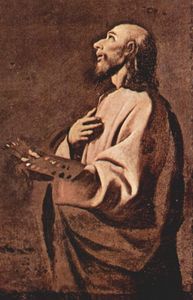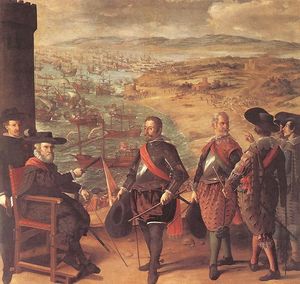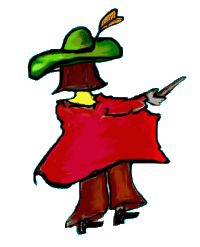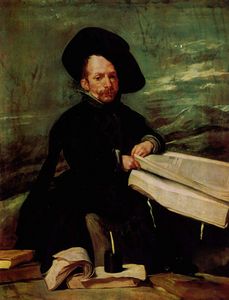The Surrender of Breda
- Date of Creation:
- 1635
- Alternative Names:
- Las Lanzas, La Rendición de Breda
- Height (cm):
- 307.00
- Length (cm):
- 367.00
- Medium:
- Oil
- Support:
- Canvas
- Subject:
- Scenery
- Art Movement:
- Baroque
- Created by:
- Current Location:
- Madrid, Spain
- Displayed at:
- Museo Nacional del Prado
- Owner:
- Museo Nacional del Prado
- The Surrender of Breda Page's Content
- Story / Theme
- Inspirations for the Work
- Analysis
- Critical Reception
- Related Paintings
- Artist
- Art Period
- Bibliography
The Surrender of Breda Story / Theme
One of the most famous of Velázquez's paintings, The Surrender of Breda depicts the moment on the fifth of June, 1625, when the Dutch general Justin Nassau surrendered the Dutch town of Breda to Spanish forces led by General Ambrosio Spínola.
The first decades of the seventeenth century were marked by the Protestant Netherland's fierce bid for independence from Catholic Spain. For the Catholic realms of Europe, Breda was suspiciously regarded as a breeding ground for heretical Protestants from all over the continent, a kind of "finishing school" where they could go to perfect their military skills.
All of Europe was warily keeping their eyes on the situation of Breda, since a battle over the possession of the city could easily escalate into a continent-wide war.
Spain had been at peace with the Netherlands during the Twelve Year Truce, but once Philip IV came to power in 1621, the truce was annulled and hostilities began anew. In 1624 Philip IV chose the best Spanish commander from the Thirty Years War, Ambrosio Spínola, to take back the city.
Progress was glacially slow during the first nine months but Spínola laid a grueling siege to the city that eventually prompted the Dutch forces to give in. Justin Nassau, commander of the Dutch forces and a renowned military man in his own right, capitulated on the condition that he and his men would be able to surrender honorably and be treated as "men of war. "
His own troops exhausted and short on materials, Spínola was in no position to argue, and on June 5, he accepted Nassau's symbolic turning over of the keys to the city in a peaceful ceremony in which no soldiers or civilians were harmed.
The Commission:
Velázquez's Surrender of Breda was part of a huge decoration project commissioned by the Spanish minister, count Olivares. In 1630, Olivares decided to glorify the image of the Spanish court by building a new pleasure palace just east of Madrid, known today as the Buen Retiro.
Olivares commissioned three separate cycles of paintings for the Hall of Realms. Velázquez was given the task of executing the equestrian portraits and one battle scene, The Surrender of Breda, which would depict the historical event of ten years ago described above. This work definitively constitutes the most important and most daring of all the paintings in the Hall of Realms, and has gone down in history as one of Velázquez's best and most intriguing paintings.
The Surrender of Breda Inspirations for the Work
Once again, as with so many of Velázquez's paintings, art historians have argued for centuries about potential sources of inspiration for his masterful composition. The most widely cited sources include the following;
Rubens:
Velázquez's close friend and prominent artist of the Flemish Baroque did not have much of an influence on Velázquez's style per se, but he has been cited elsewhere as a compositional or philosophical influence. In the case of The Surrender of Breda, Rubens had executed two paintings which have often been named in relation to Velázquez's masterpiece.
The most commonly cited painting by Rubens in this influence is his Meeting of Ferdinand of Hungary and the Cardinal-Infant Ferdinand. The paintings evidence a remarkably similar compositional structure, but the possibility of an influence has been disputed, given that the two paintings were executed at roughly the same time, and in fact, Rubens may even have been painted his after Velázquez. This may therefore be little more than a case of similar sources producing similar results.
On the other hand, Rubens's The Reconciliation of Jacob and Esau could have had an influence on Velázquez indeed, and may in fact have been the source of inspiration for Rubens's later picture. This was one of the eight paintings Rubens brought with him to Madrid, meaning Velázquez would surely have seen it.
It is generally accepted that in order to study the topography of Breda, Velázquez made use of the French Jacques Callot's engravings, Siège de Breda, which he employed in devising the landscape for his painting.
In order to fully understand what exactly happened during the surrender of Breda Velázquez would have had to avail himself of the several literary sources describing the account.
Fortunately for the artist, Velázquez was lucky enough to meet Spínola himself when the artist travelled with the military man during his first trip to Italy in 1629, and he would surely have had a first-hand account of the general's most famous triumph.
The Surrender of Breda Analysis
Although Velázquez studiously prepared his painting by studying a wide variety of sources, the end result is uniquely his own. The Surrender of Breda is considered a masterpiece for the following qualities;
Composition:
The Surrender of Breda is a particularly difficult composition for the large number of figures, the complex crowds and accessories. In order to organize and balance the painting, Velázquez employs a device he commonly uses throughout his oeuvre: he divides the action into two planes. The reality of the war and the siege is compressed into the background, reminding the viewer of the history surrounding the main event.
This main event, the actual act of the surrender, is pushed into the foreground, with its two protagonists clearly defined in the dead center: Nessau on the left, offering the keys and Spínola on the right, consoling his fellow man-in-arms.
Critics have noted that there is something very theatrical about the treatment of space, with the supporting figures tidily grouped to the left and right of the composition.
As always, realism is one of the most striking features of Velázquez's paintings. Having personally known Spínola, Velázquez would have been able to paint a veritable portrait, but the artist does not neglect to individualize the supporting cast of characters.
Color palette:
The Surrender of Breda is a surprisingly light, bright painting for Velázquez, compared to the rest of his oeuvre. For once, even pastel colors are present, in the uniformed soldiers in the background and the sweeping flags to the right of the canvas.
Many critics have attributed this lightness as well as the dominant brown, blue and yellow to the influence of the Venetians, especially Tintoretto.
Brushwork:
The Surrender of Breda evidences another example of the free, loose brushstrokes that characterize Velázquez's style, and which had such an impact on the art of Manet and the Impressionists. Here, Velázquez varies his brushstroke: in the foreground, it is tighter and more controlled, while it grows increasingly loose and abstract receding into the background, helping the artist to create a sense of atmospheric perspective.
The Surrender of Breda Critical Reception
At first glance, it would seem that The Surrender of Breda is far more straightforward than Velázquez's other paintings. After all, it is a painting about a carefully documented historical event, which remains faithful to the written eyewitness accounts. As always with Velázquez paintings, art historians have still managed to debate the actual meaning of this masterpiece.
The first, and most often accepted and promulgated, interpretation of Velázquez's The Surrender of Breda is that the painting is about a moment of humanity in the midst of the horror of war. The painting shows a Spínola who has dismounted from his horse to meet his adversary on common ground, as an equal. He ignores Nessau's gesture of offering the keys to the city, and puts his hand on his shoulder in a gesture of consolation and compassion.
This image may be one of humanity, but it would also serve as propaganda for Spanish military prowess on a variety of levels. First of all, by acknowledging the honor of her enemy, Spain makes her conquest all the greater. Secondly, by showing the overwhelming nobility and compassion of the Spanish military leader, the painting strikes a blow at the Protestant-authored reports of the cruelty and severity of the Spaniards and their Inquisition.
On the other hand, if Velázquez is actually making reference to Alciato's illustration for "Against Gifts from Enemies," an entirely different interpretation would become possible. Breda was taken aback by the Dutch a mere two years after this painting was created, in 1637, much to Count Olivares' fury.
Olivares had often warned Spínola of the danger of his lenient policies, and art historian John F. Meffitt suggests that Olivares may have suggested this iconographic program to Velázquez as a warning of what was to come. In this case, The Surrender of Breda would be like a desengaño, or disillusion or warning, against trusting the all-too-easy surrender of the Dutch.
The Surrender of Breda Related Paintings
The Surrender of Breda Artist
Velázquez's The Surrender of Breda was part of a huge decoration project commissioned by the Spanish minister, count Olivares. In 1630, even as Spain was sinking ever deeper into political and economic mire, Olivares decided to glorify the image of the Spanish court by building a new pleasure palace just east of Madrid, known today as the Buen Retiro.
This project developed into a whole complex of buildings, alleys, gardens, fountains and chapels which was devoted to various forms of courtly spectacle, including theatre and musical performances, tournaments and jousts, and the fine arts (sculpture, painting, and tapestry).
One of the greatest challenges of developing this fantastic complex, of course, was the decoration. Olivares made use of hundreds of paintings in the royal collection that had been brought to Spain from Italy and Flanders, but for the most important room in the palace, the Hall of Realms, Olivares wanted something particularly magnificent.
Olivares thus commissioned three separate cycles of paintings for the Hall of Realms: twelve paintings depicting Spanish victories under Philip IV, ten paintings from the life of Hercules (the god claimed by virtually every major European dynasty as the founder of their families), and a group of five equestrian portraits portraying Philip III and Margaret of Austria, Philip IV and Isabella of Bourbon, and the crown prince Baltasar Carlos. These portraits were intended to establish the legitimacy of the Spanish Habsburg dynasty and illustrate their succession to the throne.
Velázquez was not the only artist who was put to work to execute these numerous commissions. In fact, the busiest artist of all was his contemporary, fellow star of the Spanish Baroque, Francisco Zurbaran, who was in charge of the Hercules series and a battle scene, The Defence of Cadiz Against the English.
Velázquez was given the task of executing the equestrian portraits and one battle scene, The Surrender of Breda, which would depict the historical event of ten years ago described above. This work definitively constitutes the most important and most daring of all the paintings in the Hall of Realms, and has gone down in history as one of Velázquez's best and most intriguing paintings.
The Surrender of Breda Art Period
Diego Rodriguez de Silva y Velázquez was born into a society of paradox: Spain was simultaneously undergoing one of the most dramatic economic and political declines of any nation in European history, and unprecedentedly fertile, creative bursts of artistic activity.
In Velázquez's hometown of Seville in particular, circles of Humanist learning, arts and letters and philosophy all flourished, constituting a particularly fecund environment for a young artist.
On the other hand, Velázquez's chosen profession would become a significant obstacle in the artist's personal agenda. Spanish society was obsessed with nobility, and unlike in Italy, the visual arts were emphatically not equated with noble pursuits like literature or philosophy.
Artists were seen as essentially vulgar craftsman who worked for a living with their hands, just like blacksmiths or tailors. Making matters even more complicated, the Catholic Church exercised almost total power over the arts in Spain, dictating everything from subject to composition, meaning that artists had very little room to experiment or grow. Velázquez was thus fated to struggle from the very incipience of his career.
While most artists of the Baroque period suffered from a serious drop in critical opinion during the 18th century, eventually fading into oblivion until being rediscovered in the 1950s, Velázquez took an alternate route.
Because of Spain's political situation, the nation was more or less isolated from the rest of Europe during the heights of Neoclassicism, meaning that Velázquez's reputation was safe from the hands of Baroque-haters like Wincklemann, who managed to destroy the reputation of such artists as Caravaggio, Carracci and Bernini.
By the time Spain opened up to the rest of Europe in the beginning of the 19th century, the world was ready for Velázquez, and critics and artists alike haven't ceased singing the master painter's praises.
The Surrender of Breda Bibliography
The following list offers some of the best sources of further reading on Velázquez and his works.
• Brown, Dale. The World of Velázquez: 1599-1660. Time-Life Books, 1969
• Brown, Jonathan. Velázquez, Painter and Courtier. Yale University Press, 1986
• Carr, Dawson, et al. Velázquez. Yale University Press, 2006
• Davies, David, et al. Velázquez in Seville. National Galleries of Scotland, 1996
• Harris, Enriqueta. Velázquez. Phaidon, 1982
• Kahr, Madlyn Millner. Velázquez: the art of painting. Harper and Row, 1976
• López-Rey, José. Velázquez: A catalogue raisonné of his œuvre. Faber and Faber, 1963
• Pérez Sánchez, Alfonso, et al. Velázquez. The Metropolitan Museum of Art, 1989
• Wolf, Norbert. Diego Velázquez, 1599-1660: the face of Spain. Taschen, 1998
• Wind, Barry. Velázquez's Bodegones: A study in 17th century Spanish genre painting. Fairfax: George Mason University Press, 1987

